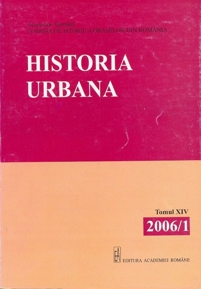Locuri şi forme de petrecere a timpului liber în mediul urban – cazul târgoviştenilor (sfârşitul secolului al XIX-lea – începutul secolului al XX-lea)
Places and Meanings of Leisure in Urban Environment – the Case of People in Târgovişte (the End of 19th Century – the Early 20th Century)
Author(s): Radu Alexandru State, Nadia ManeaSubject(s): History
Published by: Editura Academiei Române
Keywords: Romanian towns; Târgovişte; loisir; sociability; public gardens; sports’ competitions; dancing evenings;
Summary/Abstract: The spare-time spending in Romanian urban scenery, as a way for social position earmarking, before and after the first world war, was situated between traditional celebrations and meetings and experiencing new sociability ways due to increased drama performances and circus shows, cinema’s debut, enlarged and increased public gardens, indoor and open air restaurants, also of sports’ competitions organising. The modernisation specific to this époque, as a follow-up of the techniques and sciences revolution, left a strong fingerprint on the Târgovişte’s day by day life. The town’s face started to benefit from significant improvements, especially after the decision of transforming the town into a military centre. Although, this decision determined more visits of King Carol I and the Heir Prince Ferdinand, excellent occasions for mobilising the local community, from local authorities representatives to the ordinary people with no public positions but wanting to watch. The documents in The Târgovişte Town Hall Fund, many of them unrevealed yet, allowed us to rebuilt some episodes of petty urban history which can give back, even partially, those frameworks where the people of Târgovişte used to meet, to party, to accept or to avoid each other a hundred years ago. Along with the rearrangement of the old public garden at Mihai Bravu Bridge, the local authorities involved themselves in setting and arranging new green spots, even in the heart of the city where the new Town Hall building was erected or on the former place of Metropolitan Church’ garden. The private gardens, in a large number, together with the Army Hall completed the picture of the places designated to leisure activities. In these gardens, in the cattle market or in the Army Hall were held drama performances of actors from national theatres in Bucharest, Iaşi and Craiova. Not only for few times the authorities were warned about the imposition of such theatre companies. In the same place took place the balls or the more modest dancing evenings, some of them having a charity dimension. After war we can observe that the interest for learning dancing is moving towards slums, too. The 22 Military Company music was very appreciated in that time, as between the public gardens’ owners always was a strong dispute on adjudging their services. In the same time, the orchestra’s members reward by the City hall represented an almost permanent reason for high blood pressure among the members of the Local Council and Military Company commander. Starting with 1901 the people in Târgovişte took benefits from the cinema, after they experienced in advance the hybrid form of panorama. After the First World War the film projections were taken place in the Elisée and Arms’ Hall, in Florea Pârvulescu nightclub and Lăzărescu Brewery. The cinema occurrence represented a challenge for local authorities too, that settled a new Technique Department whose tasks were to check the good functioning of projections’ devices
Journal: Historia Urbana
- Issue Year: XIV/2006
- Issue No: 1
- Page Range: 49-66
- Page Count: 18
- Language: Romanian
- Content File-PDF

